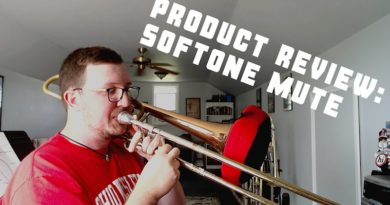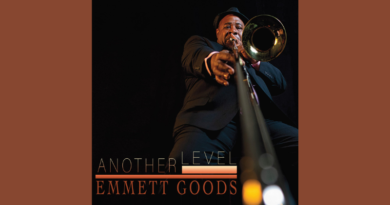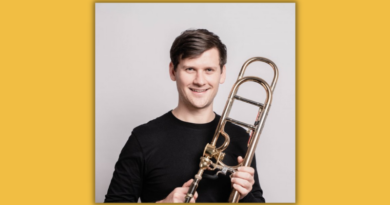Trombone Masterclass with Ross Holcombe at BGSU
Last week, before the coronavirus pandemic hit the USA, I was fortunate to attend Bowling Green State University’s final guest artist event of the semester. Ross Holcombe, Assistant Principal Trombone of the Florida Orchestra, was originally planning to make visits in Pennsylvania, Ohio, Indiana, and Illinois, but was cut short to only visiting the first two states in his journey. Not distracted by the outside world chaos, Ross was able to focus on clear artistry and effective teaching with the trombone students of Dr. Brittany Lasch, Assistant Professor of Trombone at BGSU.
After speaking of the unique ideas that each musician brings to a piece of music, Holcombe performed an eloquent rendition of Vincent Persichetti’s Parable XVIII for Solo Trombone. Providing a handout (See PDF) as the basis for the masterclass, Holcombe was able to pinpoint key ideas for each student performing in the masterclass.

Starting with Giovanni Pergolesi’s Sinfonia in F Major, Holcombe expounded on ideas of improving the ear and improving the airflow. The following points (paraphrased) were made:
- Every time you improve a passage, it is going to get better and not worse as long as you keep striving to improve the passage.
- Flutter tongue a phrase as this keeps the air and embouchure very consistent.
- Follow the practice steps of 1) Flutter -> 2) Glissando -> 3) Legato tongue -> 4) As Written (See PDF)
This led to Holcombe discussing a concept called the “Overlay System” taught by his teacher/mentor, Normal Bolter, retired Second Trombone of the Boston Symphony Orchestra. The three overlays are:
- #1 – Automatic Processes
- your technique in playing the instrument and music
- #2 – Choices/Skills
- your use of phrasing, dynamics, expression, etc.
- #3 – Integration and the Art
- Answer the question of “Is this music happy or sad?”
- Note: there may not be a right or wrong answer to this.
- Think of happy or sad memory for the specific piece
- How will you connect that emotion NOT to the trombone but to that memory?
- If you focus on Point #3, you may improve the other two overlays.
- Answer the question of “Is this music happy or sad?”

The next student in the masterclass performed Enrique Crespo’s demanding Improvisation for solo trombone. While ideas of connection to the audience were discussed, the biggest takeaway during this segment was on improving the chops so the soloist could tackle the leaps and bounds throughout this piece. Holcombe was able to give a clear description of finding the best sound by finding the best position for your lips. By controlling the size of the aperture, we are able to focus on that beautiful, crisp sound that we hear so often in the sounds of great brass players. Three components can achieve this:
- Start your lips very wide on the mouthpiece and bring them in closer until you hear (and feel) that beautiful, resonant sound.
- Keep your lips shut then try to blow the air out so fast that the lips open on their own.
- By using an air attack such as “Buh” or “Puh,” the lips can vibrate instantly without the tongue helping to start the note.
While the audience could tell a distinct difference, Holcombe brought up that practicing this will be about keeping a “can do” attitude and a desire to improve the sound.

The last student of the afternoon’s masterclass performed Norman Bolter’s Arctic Emanations. In a beautiful manner, this piece is marked with details on the different images that portray the Arctic landscape. A few of the takeaways brought up during this segment include:
- When the music changes moods, your approach to the piece should immediately change.
- Try something new to the style of the music while still accepting that, if you crack a note, you are moving forward in your understanding and interpretation of the piece. Be sure to regroup if a mistake happens and try again to make sure you don’t revert back to the old way.
The previous point led to an important talk on making sure that we don’t let a deadline (jury, recital, etc.) define how we practice. On the last major point of the handout, Holcombe discusses the causes of inferior performances. For the students, he discussed that it is crucial to know how to fix something on the fly during a performance. In the practice room, he mentioned that it is important to practice this skill so you know how to respond if a mistake or bump derails you off course.
To finish the masterclass, students were able to ask Holcombe some “rapid-fire” questions (paraphrased):
- Q – What are some trombone pieces not performed enough that we should be performing?
- A – Philippe Gaubert’s Morceau Symphonique and Sigismond Stojowski Fantasy for trombone.
- Q – What should we focus for practicing over Spring Break with the possibility of not coming back to BGSU for the semester due to Covid-19?
- A – Try learning some new pieces, and find where in the music you “can do” it well. Give yourself assignments, and keep practicing new, fresh music that you may not know at first.
All in all, for those in attendance, this was an insightful and effective masterclass that prepared all students for their long-term break from in-person learning.
Photo Credits: Brittany Lasch; BGSU Trombone Studio



